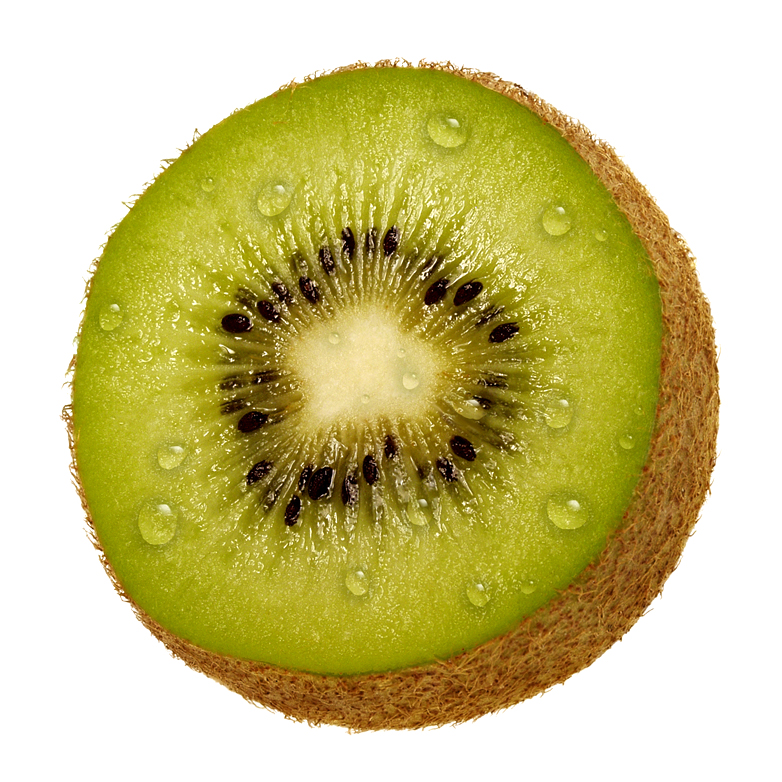
|
KIWI |

|
-
Basic information
- Where are they grown? This fruit is native to China and had a long history before it was commercialized as kiwifruit. Hence it has many other older names especially in the Chinese language.
- Where is the Kiwi in season? November to May The long growing season required for fruit to mature can also limit production. A frost free period of at least 220 days is required for adequate fruit ripening. In southeastern North Carolina, the vines can be expected to leaf in mid- to late-March and flower in mid-May. Fruit should be sufficiently mature for harvest in late October or early November. Temperatures lower than 29°F between leafing and harvest can damage the leaves, blossoms and fruit. If new growth is damaged in the spring before blossoms develop, no blossoming will occur. A. arguta has been reported to tolerate winter temperatures as low as -25°F, but freeze damage to new growth in the spring is similar to the damage described for A. deliciosa. A. arguta fruit begins ripening in mid-August in southeastern North Carolina.
- How do you know the Kiwi is ripe?
- Benefits
- In the world of phytonutrient research, kiwifruit has fascinated researchers for its ability to protect DNA in the nucleus of human cells from oxygen-related damage. Researchers are not yet certain which compounds in kiwi give it this protective antioxidant capacity, but they are sure that this healing property is not limited to those nutrients most commonly associated with kiwifruit, including its vitamin C or beta-carotene content. Since kiwi contains a variety of flavonoids and carotenoids that have demonstrated antioxidant activity, these phytonutrients in kiwi may be responsible for this DNA protection. The protective properties of kiwi have been demonstrated in a study with 6- and 7-year-old children in northern and central Italy. The more kiwi or citrus fruit these children consumed, the less likely they were to have respiratory-related health problems including wheezing, shortness of breath, or night coughing.
- Kiwifruit emerged from our food ranking system as an excellent source of vitamin C. This nutrient is the primary water-soluble antioxidant in the body, neutralizing free radicals that can cause damage to cells and lead to problems such as inflammation and cancer. In fact, adequate intake of vitamin C has been shown to be helpful in reducing the severity of conditions like osteoarthritis, rheumatoid arthritis, and asthma, and for preventing conditions such as colon cancer, atherosclerosis, and diabetic heart disease. And since vitamin C is necessary for the healthy function of the immune system, it may be useful for preventing recurrent ear infections in people who suffer from them.
- Eating vitamin C-rich fruit such as kiwi may confer a significant protective effect against respiratory symptoms associated with asthma such as wheezing.
- Our food ranking system also qualified kiwifruit as a very good source of dietary fiber. The fiber in kiwifruit has also been shown to be useful for a number of conditions. Researchers have found that diets that contain plenty of fiber can reduce high cholesterol levels, which may reduce the risk of heart disease and heart attack. Fiber is also good for binding and removing toxins from the colon, which is helpful for preventing colon cancer. In addition, fiber-rich foods, like kiwifruit, are good for keeping the blood sugar levels of diabetic patients under control.
Kiwifruit can be grown in most temperate climates with adequate summer heat. Where Actinidia deliciosa is not hardy, other species can be grown as substitutes.
Kiwifruit is commercially grown on sturdy support structures, as it can produce several tonnes per hectare, more than the rather weak vines can support. These are generally equipped with a watering system for irrigation and frost protection in the spring.
Kiwifruit is very slow to ripen in the first couple of months after harvest. In the last few weeks, the World's supply of kiwifruit has switched to growing regions in the Southern Hemisphere. The fruit is very slow to ripen, at this point because it has more chance of propogating if ripening doesn't take place until spring. to accelerate it's ripening, you should keep the kiwifruit warm and near a source of ethylene gas, which is a byproduct of the ripening process of certain climacteric fruits (ones that ripen after harvest). Your best source of ethylene in your house is your bananas and your apples. Place the kiwifruit in a paper bag on top of the fridge with either of these fruits, until it softens. Once kiwifruit is ripe, it can be stored in the fridge for 3 to 4 weeks
In about two months you'll notice that the kiwifruit that you buy will ripen much more quickly, since the fruit is now more mature. At that time, you'll want to make sure that it doesn't become overripe. But alas, in October or November the supply will switch to the Northern Hemisphere, and you'll find that in November and December that the fruit will be very slow to ripen again.
For maximum storage life, store kiwifruit alone. Fruit will ripen at room temperature when removed from cold storage. Ripening can be hastened by exposure to ethylene. This hastened ripening can be accomplished in the home by placing kiwifruit in a plastic bag with an apple.

HEDGE APPLE |
AUBERGINE GUAVA CHERIMOYA JUCK FRUIT GUARANA KUMQUAT MANGO
|
go to top
|
If you need more information you can go to the web side Frutas and if you have any question o comment Send e-mail Promoter Companie Horticulture |